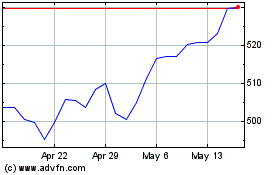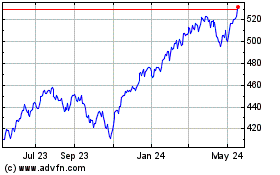All Eyes on Fed as the S&P 500 Index Remains Volatile
September 18 2022 - 5:22PM
Finscreener.org
All three major equity indices in
the United States traded in the red last week. Investors were
spooked by higher-than-expected CPI (consumer price index)
inflation data which triggered the possibility of an aggressive
monetary tightening policy by the Federal Reserve at their upcoming
policy meeting.
In the week ended on September
16, the
S&P 500 fell 4.8%,
while the
Dow Jones Industrial Average and Nasdaq declined by 4% and 5.5%, respectively.
Comparatively, the 10-year Treasury yield closed at 3.45%, its
highest level since June, while the two-year yield rose to 3.87%,
the highest level since 2007.
The yield curve inversion between
the
10-year yield and the
two-year yield has widened. The inverted yield curve is considered
a recession indicator, and the Fed might trade an economic slowdown
to offset rising inflation.
Further, the price of West Texas
Intermediate crude traded at $85 per barrel and was under pressure
as a global recession is bound to impact energy demand.
As we come to the end of Q3, the
S&P 500 index is trading close to bear market territory and
is down 19.3% from all-time highs. The Nasdaq and Dow indices have
fallen 28% and 16% from record highs, respectively.
Let’s see what events in the
upcoming week will drive the equity markets.
Policy meeting of key central banks
The U.S. Federal Reserve will
begin its two-day policy meeting on Tuesday. It is likely to hike
interest rates and subsequently hold a press conference on
Wednesday. Most economists forecast the Fed to hike interest rates
by 75 basis points, while a few are anticipating a 100 basis point
hike. Since March, the central bank has raised the benchmark funds
rate by 225 basis points to combat higher commodity prices as
inflation soared to 40-year highs.
Other central banks, such as the
United Kingdom and Japan, are also scheduled to hold policy
meetings this week. The Bank of England or BoE is on track to
increase benchmark rates on Thursday as inflation is the highest
among G-7 countries. In August, the BoE hiked rates by 50 basis
points, which was the largest increase since 1995. The benchmark
rate in England is around 1.75%.
However, Japan’s central bank is
holding interest rates at record lows as inflation remains at
manageable levels for the export-oriented economy. There is a
chance for Japan to even undertake quantitative easing measures if
required.
Housing market under pressure
The U.S. Census Bureau will
publish data on August housing starts and building permits on
Tuesday. It will basically track the construction of new housing
units for the last month. Housing starts are forecast to fall to
1.44 million units in August, compared to 1.446 million units in
July, due to higher rising materials costs.
Additionally, rising interest
rates have also impacted demand as consumer savings are under
pressure. Building permits are expected to decline to 1.61 million
in August from 1.685 million in July.
The National Association of
Realtors (NAR) will provide an update on existing home sales in
August on Wednesday. Analysts project existing home sales to fall
to 4.7 million units in August, compared to 4.81 million in
July.
These numbers have now fallen for
six consecutive months after touching a peak of 6.49 million in
January.
According to Investopedia,
“Freddie Mac reported this week that the average rate on a 30-year
fixed-year mortgage rose above 6% for the first time since 2008,
putting further pressure on potential homebuyers.”
SPDR S&P 500 (AMEX:SPY)
Historical Stock Chart
From Feb 2025 to Mar 2025

SPDR S&P 500 (AMEX:SPY)
Historical Stock Chart
From Mar 2024 to Mar 2025
